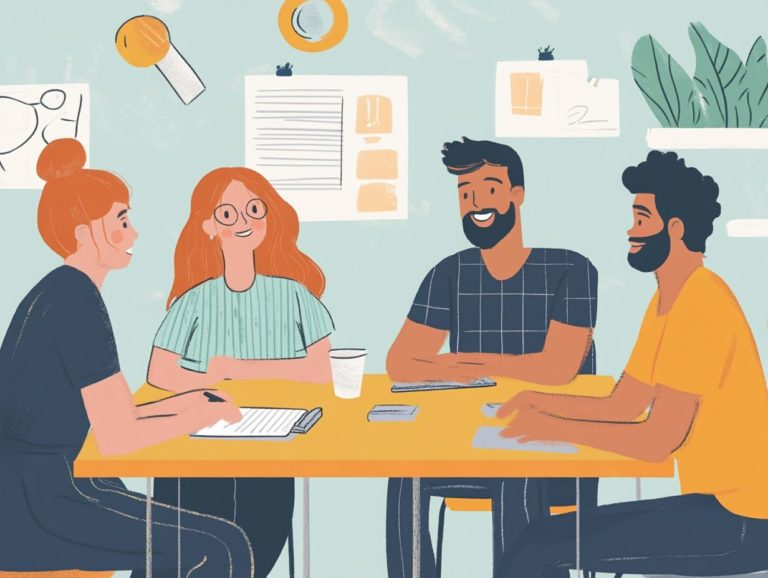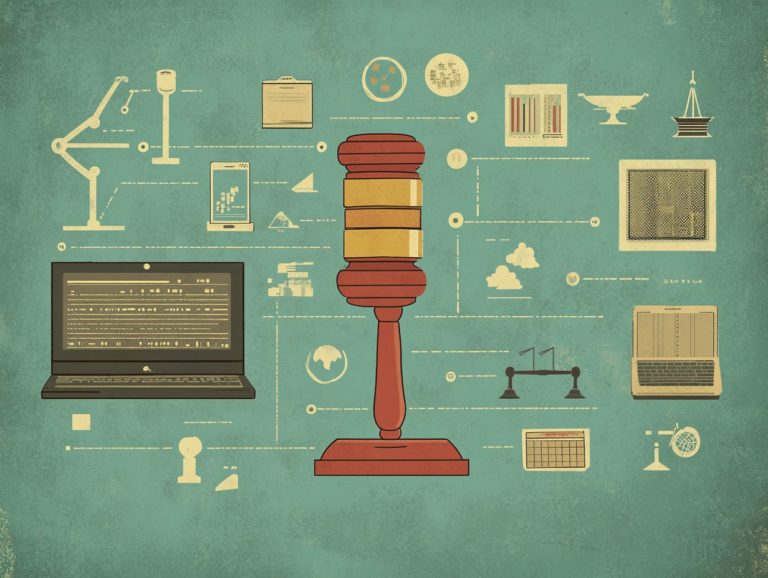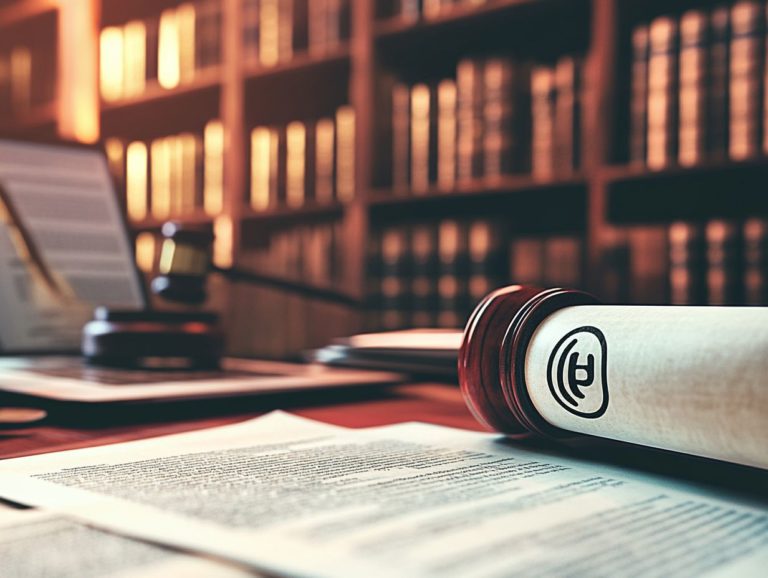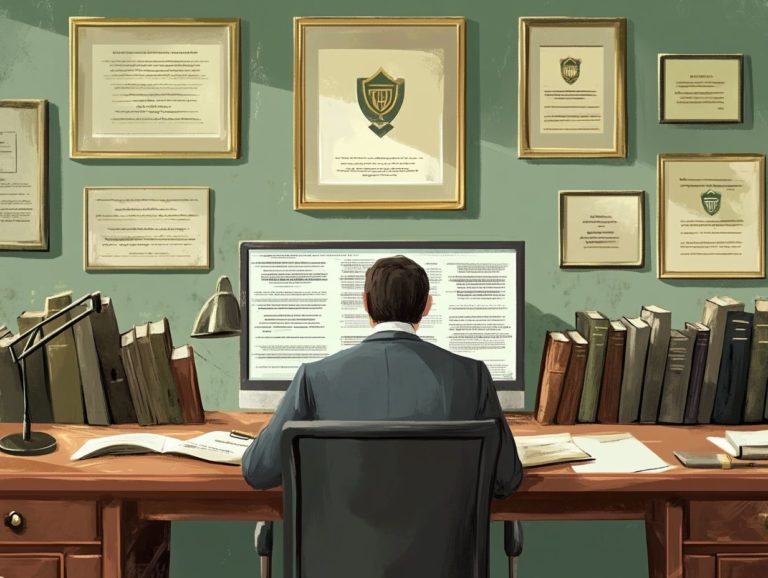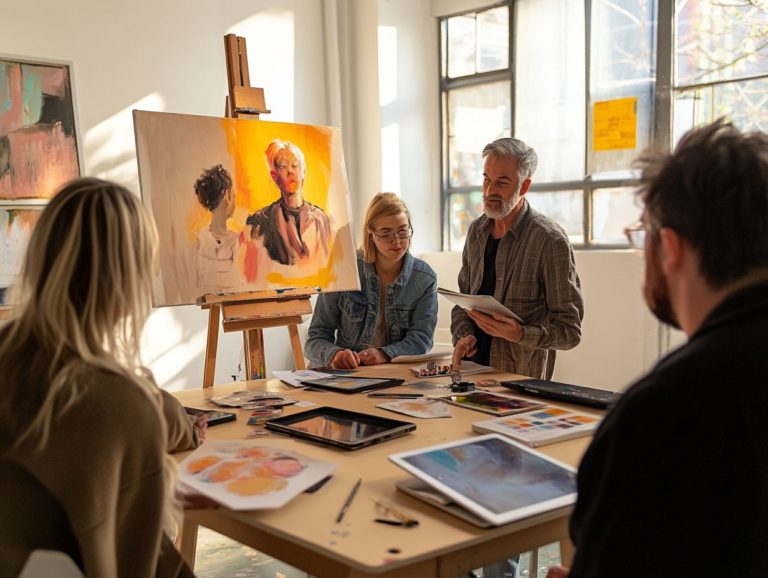5 Best Practices for Copyright Compliance
In an age where content reigns supreme, understanding the nuances of copyright compliance is crucial as you navigate the digital landscape. One wrong step can lead to costly legal troubles, making it imperative to grasp the intricacies of copyright laws.
This article highlights five best practices to ensure compliance, covering everything from understanding regulations to tracking copyright expiration dates. It also delves into common misconceptions, the repercussions of infringement, and how maintaining proper compliance not only shields your business but also elevates its reputation.
Jump in now to gain essential knowledge necessary for your business to thrive both legally and ethically.
Contents
- Key Takeaways:
- 1. Understand Copyright Laws and Regulations
- 2. Obtain Permission for Using Copyrighted Material
- 3. Give Proper Attribution to Copyright Holders
- 4. Keep Track of Copyright Expiration Dates
- 5. Stay Updated on Changes to Copyright Laws
- What Are the Consequences of Copyright Infringement?
- How Can a Business Ensure They Are Compliant with Copyright Laws?
- What Are the Common Misunderstandings About Copyright Compliance?
- How Can a Business Protect Themselves from Copyright Infringement?
- What Are the Benefits of Copyright Compliance for Businesses?
- What Are the Different Types of Copyright Licenses?
- Frequently Asked Questions
- What are the 5 best practices for copyright compliance?
- Why is it important to understand the laws about using creative work?
- Do I always need to obtain permission before using copyrighted material?
- What is proper attribution, and why is it important?
- Is it necessary to keep track of my usage of copyrighted materials?
- Why is it important to regularly review and update policies and procedures?
Key Takeaways:

- Understand copyright laws to avoid infringement.
- Obtain permission before using copyrighted material.
- Always credit original copyright holders.
1. Understand Copyright Laws and Regulations
Understanding copyright laws and regulations is essential for educators, students, or content creators. These laws safeguard original works and provide the ability to use copyrighted material under specific conditions, as outlined in the U.S. Constitution and the guidelines from the Copyright Office.
Copyright protects your original work from being used without your permission. Fair use allows you to utilize copyrighted material for educational, commentary, or research purposes without needing formal permission.
Works in the public domain are available for anyone to use, enhancing accessibility. By navigating Creative Commons licenses, you can legally distribute and remix materials, fostering collaboration and innovation in your teaching endeavors.
Understanding these principles is vital when creating educational resources, as they help cultivate an environment where knowledge can be shared responsibly and effectively.
2. Obtain Permission for Using Copyrighted Material
Obtaining permission to use copyrighted material is essential for instructors and educational institutions. This ensures compliance with copyright laws and helps you avoid any infringement issues when incorporating licensed works into your teaching materials.
The process begins by identifying specific materials you need be it texts, images, or videos and then locating the copyright holder to request permission. For example, you might draft a succinct email to a publisher, clearly stating your intent to use a chapter from a textbook for classroom purposes.
Keep a record of these communications and any permissions granted. Neglecting to secure necessary permissions could lead to serious consequences, including legal action, financial penalties, and damage to your institution s reputation. This can ultimately hinder the educational experience you strive to provide.
3. Give Proper Attribution to Copyright Holders
Giving proper attribution to copyright holders is crucial for maintaining academic integrity. This practice ensures that original works are credited accurately, especially when you re using materials licensed under Creative Commons.
Respecting the creator s rights enhances the credibility of your research by showcasing transparency in how you use various sources. When incorporating quotes, images, or data from others, it s crucial to adhere to established citation guidelines, such as APA, MLA, or Chicago style.
Including an in-text citation alongside a comprehensive reference list enables others to locate the original materials, encouraging further inquiry and learning. By consistently providing attribution, you contribute to a culture of ethical resource usage, fostering an environment where knowledge can be freely shared and built upon while minimizing the risk of plagiarism or misinformation.
4. Keep Track of Copyright Expiration Dates

Keeping track of copyright expiration dates is essential for educators and content creators. Once copyright protection lapses, works enter the public domain, allowing you to use them freely without needing permissions or licenses.
Understanding when a work transitions into the public domain opens up a treasure trove of possibilities for innovative teaching methods and enriched learning experiences. You can develop lesson plans, create engaging educational resources, and inspire fresh creative projects based on these freely accessible materials.
To effectively monitor these critical dates, leverage databases and tools that keep you informed about copyright statuses and impending expirations. By implementing a systematic approach to archiving your original works, you ensure that when a creation becomes eligible for broader use, it is readily available for adaptation and distribution, fostering an environment of collaborative learning.
5. Stay Updated on Changes to Copyright Laws
Staying updated on changes to copyright laws is essential for educators. Evolving legislation can greatly influence fair use guidelines, educational exemptions, and your ability to use Creative Commons materials in teaching.
To access reliable resources, consider subscribing to reputable legal journals, joining professional organizations, and engaging in online communities focused on copyright issues.
Understanding how these changes impact your educational practices is crucial; it gives you the power to navigate the legal landscape effectively, ensuring compliance while maximizing your teaching potential.
Advocacy plays a vital role in copyright reform, encouraging you to voice your concerns and support initiatives that promote more flexible and equitable copyright practices.
By remaining informed and involved, you can contribute to shaping an environment where educational innovation flourishes.
What Are the Consequences of Copyright Infringement?
The consequences of copyright infringement can be quite severe for instructors and students alike. Legal penalties and reputational damage to educational institutions make it essential for everyone to grasp and adhere to copyright laws when using licensed works.
Infringement can lead to hefty fines, sometimes soaring into the thousands, along with the looming threat of lawsuits that can deplete both financial and human resources. It s not just about the money; such violations can seriously tarnish an institution s credibility, eroding trust among students and faculty.
Consider the case of the University of Florida, which settled a copyright lawsuit for a staggering $600,000 after posting materials online without authorization. This serves as a vivid reminder of the serious consequences of ignoring copyright laws.
Ongoing disputes over digital content in classrooms illustrate the chilling effect on academic integrity, making educators feel pressured to steer clear of certain materials altogether.
How Can a Business Ensure They Are Compliant with Copyright Laws?
To ensure compliance with copyright laws, establish structured processes for obtaining permission requests and responsibly using licensed works. Following the 5 best practices for documenting IP rights can help minimize the risk of infringement.
This might include offering regular training sessions for employees, highlighting the significance of understanding copyright issues and the repercussions of non-compliance.
Maintaining detailed records of all permissions sought and granted is equally crucial; this documentation serves as evidence of your good faith efforts should any disputes arise.
Consulting with legal experts who specialize in intellectual property can also be beneficial, as they will keep you informed about evolving regulations and best practices.
By adopting these proactive measures, your organization not only protects its interests but also cultivates a culture that respects creativity and innovation.
Stay informed and start monitoring your copyright dates today!
What Are the Common Misunderstandings About Copyright Compliance?

Common misunderstandings about copyright compliance often lead to unintentional violations, especially regarding fair use and educational exemptions. To navigate these challenges effectively, it’s important to follow the best practices for trademark management, as many people mistakenly believe these concepts allow unlimited use of copyrighted materials.
In truth, fair use involves complex rules that offer some leeway for educational and transformative purposes. However, it comes with specific criteria to consider. Factors such as the purpose of use, the nature of the copyrighted work, the amount used, and the impact on market value are all critical in determining whether your use qualifies as fair.
Using a small excerpt doesn t automatically qualify for fair use. It s crucial to pay attention to context and intended use.
To effectively navigate educational exemptions, seek guidance on your institution’s specific policies. Additionally, consider implementing best practices for trade secret compliance that respect the rights of copyright holders while creating a supportive learning atmosphere.
How Can a Business Protect Themselves from Copyright Infringement?
You can safeguard your business from copyright infringement by investing in proper content creation practices. It’s important to follow key considerations for copyright licensing and ensure that all licensed works are used strictly according to copyright laws.
It’s wise to create comprehensive copyright policies that clearly outline acceptable usage guidelines and protocols. Implementing tips for protecting your copyrighted work can shield you from potential legal disputes.
Implement regular training sessions for your staff to educate them about copyright issues and the importance of compliance in their daily operations. Additionally, refer to the 5 best practices for international IP compliance and conduct periodic audits of your existing content to identify any potential violations, allowing you to rectify issues before they escalate.
By fostering a culture of awareness and accountability around copyright matters, you minimize risks and enhance your overall operational integrity, as highlighted in 5 ways to avoid copyright issues on social media.
What Are the Benefits of Copyright Compliance for Businesses?
Copyright compliance offers numerous benefits for your business, such as enhancing academic integrity, bolstering your reputation, and allowing you to share resources responsibly minus the anxiety of legal troubles.
By committing to copyright laws, you create an environment where creativity flourishes and collaboration is the norm. To further enhance your understanding, consider exploring essential resources for copyright owners. This dedication to ethical practices builds trust with your stakeholders and strengthens relationships with clients, partners, and the broader community.
Stakeholders are more inclined to engage with a business that embodies fairness and transparency, amplifying your organization s credibility.
By weaving compliance into your corporate culture, you encourage responsible resource sharing, ensuring that intellectual property is respected and that creative contributions receive the acknowledgment they deserve. This approach sets the stage for sustainable growth and innovation.
What Are the Different Types of Copyright Licenses?
Understanding the various types of copyright licenses, especially those offered by Creative Commons, is crucial for you as a business owner or educator. Knowing these allows you to utilize licensed works effectively while honoring the rights of original creators.
These licenses vary significantly, ranging from highly permissive options that allow unrestricted use and modification to more restrictive ones that limit use to non-commercial applications. For example, a Creative Commons Attribution license enables you to share and adapt the work freely, provided you give proper credit. This makes it particularly well-suited for educational environments.
Conversely, a No Derivatives license permits sharing but strictly prohibits adaptations, which can greatly influence how you utilize materials.
To determine which license applies to specific works, carefully review the licensing terms set forth by the creator or publisher. This diligence ensures that you comply with the stated permissions and restrictions, safeguarding both your endeavors and the rights of original creators.
Frequently Asked Questions

What are the 5 best practices for copyright compliance?
The 5 best practices for copyright compliance are:
- Understand the laws about using creative work and their regulations.
- Obtain permission before using any copyrighted material.
- Give proper attribution when using someone else s work.
- Keep track of your usage of copyrighted materials.
- Regularly review and update your policies and procedures.
Why is it important to understand the laws about using creative work?
Understanding these laws is crucial because they dictate how you can use someone else’s creative work. By knowing the rules, you can ensure compliance and avoid legal consequences.
Do I always need to obtain permission before using copyrighted material?
Yes, in most cases, you need to get permission from the copyright holder, the person or company that owns the work, before using it. This applies to any type of use, whether for commercial or non-commercial purposes.
What is proper attribution, and why is it important?
Proper attribution means giving credit to the original creator of the work. It is essential for showing respect for creators and avoiding legal issues. It also helps the audience know the source of the material.
Is it necessary to keep track of my usage of copyrighted materials?
Yes, keeping a record of your usage is crucial. It helps you track the permissions you have obtained and any changes in your usage over time. This record can also serve as evidence of compliance with the law in case of legal disputes.
Why is it important to regularly review and update policies and procedures?
Regularly reviewing and updating your policies ensures they align with current laws and regulations. This proactive approach helps avoid unintentional violations and keeps your organization compliant with best practices.


